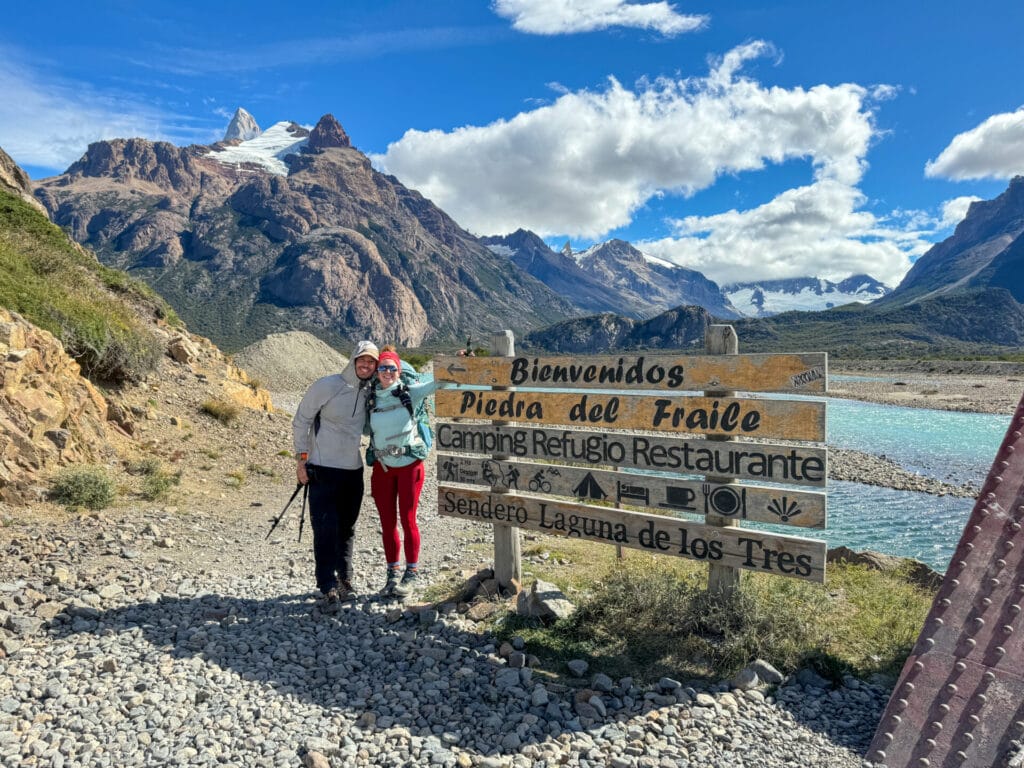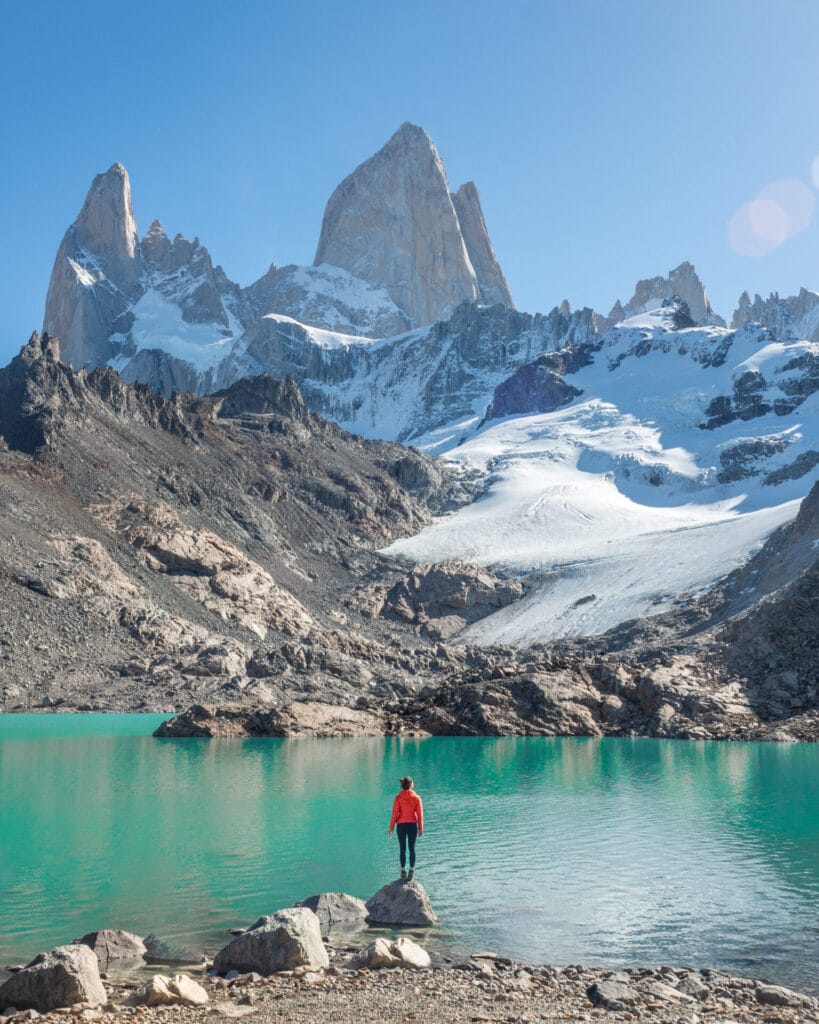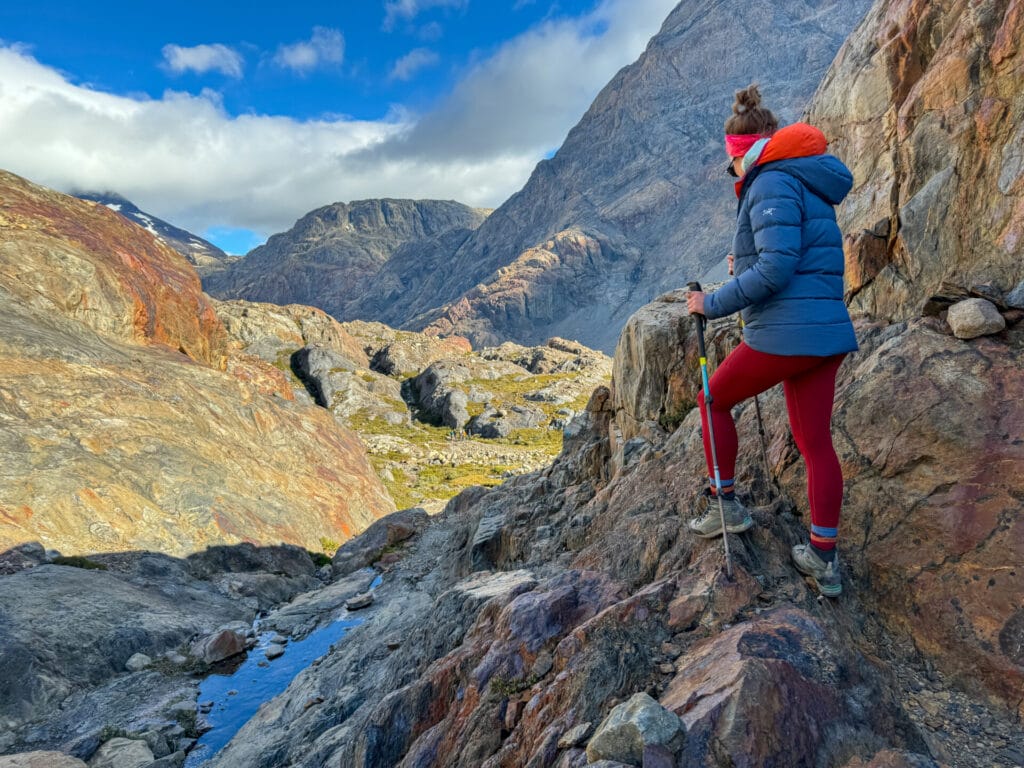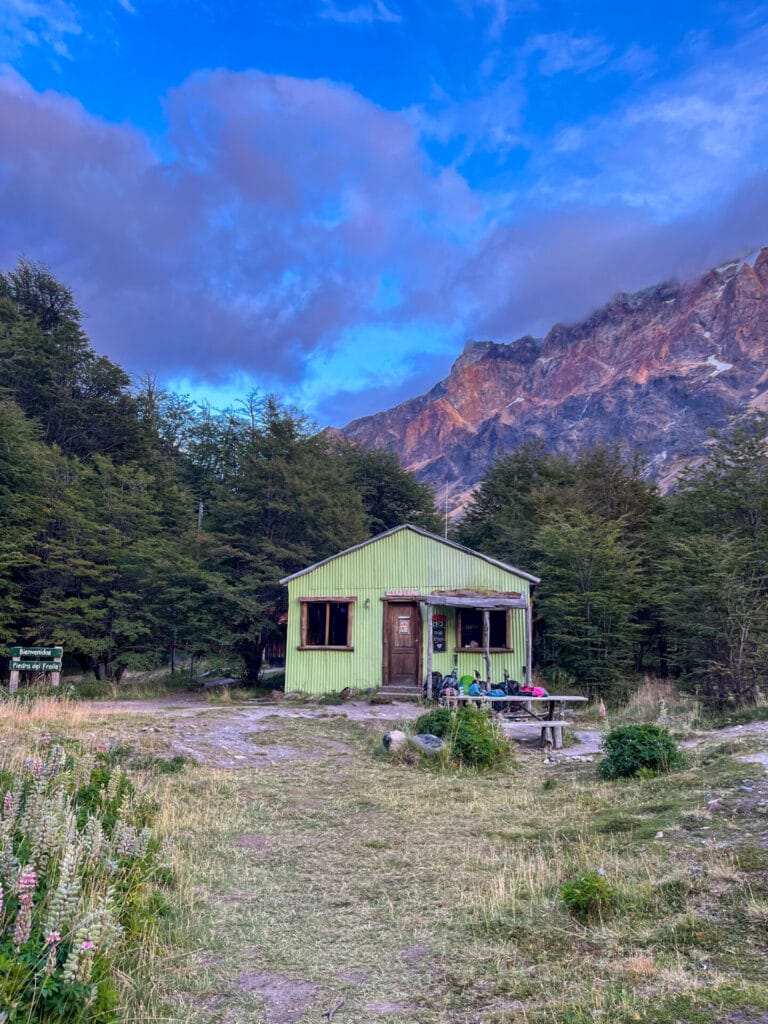
Fitz Roy Loop: the ultimate 3-day backpacking trip in El Chaltén, Patagonia
Argentina’s hiking capital, El Chaltén, sits in the shadow of the towering Fitz Roy Massif and is the launch point for some of the most scenic day hikes in all of Patagonia. This custom 3-day loop links two of the area’s most iconic trails (Laguna de los Tres and Laguna Torre) with quieter, less-travelled corners of Parque Nacional Los Glaciares for an unforgettable backpacking adventure.
I’ve been to El Chaltén THREE times in the last decade— I turned 21 at Laguna de los Tres in January 2015, returned to hike the loop again in March 2023, and even hosted a group hiking trip here in February 2024 that included a new extension to Laguna Pollone. This hiking guide is the result of all that trail time: a complete backpacking itinerary (plus modifications for 2 or 4 days), campsite info, and everything you need to plan your own adventure around El Chaltén!
🏔️ Read my El Chaltén packing list & check out my custom Fitz Roy Loop GPS map for route navigation
About Parque Nacional Los Glaciares
Spanning the southern Andes in Argentine Patagonia, Parque Nacional Los Glaciares is the country’s largest national park and a designated UNESCO World Heritage Site protecting over 7,000 square kilometres of wild Patagonian terrain. This includes 40 major glaciers, the Southern Patagonian Ice Field (the world’s second-largest extrapolar ice mass), and some of the most spectacular alpine scenery in South America— jagged granite spires, glowing blue glaciers, and crystal-clear lakes tucked beneath towering peaks.
The park is divided into two main trekking zones: El Calafate, home to the famous Perito Moreno Glacier, and El Chaltén, the heart of the action for hikers and climbers. This guide focuses on the northern section around El Chaltén, where an extensive free-to-access trail network winds through lenga forests, past glacial lakes, and right up to the foot of the country’s most iconic peak, Mt Fitz Roy.
🏔️ Read more about El Calafate & Los Glaciares in this post: 2-week Patagonia itinerary: best of Torres del Paine & Los Glaciares/El Chaltén

About the Fitz Roy Loop
Unlike the incredibly developed W-Trek in Torres del Paine or other famous treks in Patagonia, the Fitz Roy Loop isn’t an official trail, per se. Instead, it’s a clever way to connect several of El Chaltén’s most popular day hikes into a single multi-day route— there are countless options, which is excellent for varied itineraries but can be a little overwhelming when it comes to planning!
Most backpackers opt for a 2-day loop that links Laguna Torre and Laguna de los Tres, but if you’ve got more time, it’s definitely worth extending your hike to include Laguna Pollone, Piedra del Fraile, and more of the stunning Rio Eléctrico Valley. Here’s my recommended route:
- Duration: 3 days
- Total distance: 60km (37mi)
- Total elevation gain: 2,000m (6,560ft)
- Difficulty: moderate (no technical terrain, but heavy packs, changeable weather, and a few steep climbs make this more than a walk in the park)

How many days do you need?
Although it’s absolutely possible to tackle a version of the Fitz Roy Loop in 2 days (staying only at Poincenot Camp), I’ve written up the Fitz Roy Loop as a 3-day backpacking trip with a few specific thoughts in mind:
- The weather in Patagonia is wildly unpredictable and the first time I did this loop, I didn’t even see Fitz Roy. By slowing the itinerary down slightly, you’ll give yourself the chance to visit Laguna Torre and Laguna de los Tres in the afternoon upon arrival into camp AND at sunrise before leaving camp— 2 chances for the clouds to cooperate and for you to experience the insane landscapes you travelled all the way to Patagonia for!
- You’ll only need to hike with your full pack for about half of each day (while moving camp) and then you can drop weight in your tent and ascend to each of the viewpoints with only a light daypack (shown in italics below). This makes for a less demanding route while still visiting ALL the same iconic Lagunas!
- Camping is free in Parque Nacional Los Glaciares and no reservations are required, so adding an extra night into the itinerary costs nothing AND gives you more time to enjoy Patagonia.
🏔️ 3-DAY FITZ ROY LOOP ITINERARY
DAY 1: El Chaltén to D’Agostini Camp (2.5hrs; 8.5km; +330m)
+ Laguna Torre (1hr; 5km; +200m)
DAY 2: D’Agostini Camp to Poincenot Camp (2.5hrs; 10.5km; +300m)
+ Laguna de los Tres/Piedras Blancas (3.5hrs; 9.5km; +640m)
DAY 3: Poincenot Camp to Piedra del Fraile (2.5hrs; 11.5km; +180m)…
+ Laguna Pollone (2hrs; 8km; +300m)
… Piedra del Fraile to Río Eléctrico (1.5hrs; 7km; +50m)

Planning your Fitz Roy Loop hike
When to hike in El Chaltén
The hiking season in El Chaltén runs from November to April, with the best conditions typically found from mid-December through March. During this time, trails are mostly snow-free, campsites are accessible, and weather is slightly more dependable. Here’s what to expect across the main hiking season:
- November: the start of the season boasts quiet trails, but some lingering snow or muddy sections are still possible at higher elevations like Laguna de los Tres
- December – February: peak season in El Chaltén, with up to 17hrs of daylight, mostly clear trails, and the warmest temperatures of the year, BUT the Southern Hemisphere summer also brings Patagonia’s famously strong winds and bigger crowds in the park
- March: my personal favourite month to hike in El Chaltén, with fewer people, beautiful autumn colours, and cooler temperatures; just be prepared for shorter days and a slightly higher chance of rain or early snow!

Even during the hiking season, rain, snow, and wild winds are always possible— check the weather before setting out and make sure your boots, camping gear, and warm layers are prepared to handle Patagonian conditions! Read my full Fitz Roy Loop packing list for specific gear recommendations.
*Just to really illustrate this point about weather, here are two photos at Laguna de los Tres taken just THREE DAYS APART in March: I had gorgeous clear skies and warm enough conditions to strip down to a sports bra, but James hiked to this exact same viewpoint in full blizzard conditions. Patagonia is WILD, do not underestimate the weather swings!


Camping in Parque Nacional Los Glaciares
In contrast to the wild reservation system that has evolved on the Chilean side of Patagonia (where you need to reserve campsites up to 6 months in advance during peak season), the camping in Los Glaciers is blissfully simple: all campsites in the Fitz Roy sector are FREE & first-come, first-served, with no permit or reservation required!
Camp facilities include a pit toilet, a large flat area for tents in the trees, a nearby natural water source (safe to drink, since it’s glacier run-off), and a thriving mouse population…
🐭 MICE AT D’AGOSTINI & POINCENOT CAMPS
In recent years, a significant mouse problem has developed in the campsites around Fitz Roy, and if you’re not careful, mice WILL nibble their way inside your tent and tap-dance around at night. I woke up with a mouse IN MY HAIR during my 2nd time camping at Poincenot, and although none of the guests on my group trip in 2024 had any issues with mice, I’d still recommend storing ALL scented items (food & toiletries) in a rodent-proof sack AWAY from your tent, ideally hanging in a tree.
Essential resources & maps
The trail network around El Chaltén is fairly well-signed and easy to follow, but a map or GPS file still comes in handy to track distances, identify key landmarks, and navigate confidently on quieter sections of the route. I built a custom GPS track for the 3-day Fitz Roy Loop described in this post; download it as a JSON or GPX file for offline use on the trail!

Getting to & from the Fitz Roy Loop
Getting to El Chaltén
The easiest way to reach El Chaltén is via El Calafate, which has a small airport with daily flights from Buenos Aires and other major cities in Argentina. Even if you’re coming from Chilean Patagonia, you’ll need to connect through El Calafate to reach El Chaltén (and possibly stopover to see Perito Moreno Glacier!).
From El Calafate Airport OR the bus terminal, take a 2.5hr bus to El Chaltén (bookable through Chaltén Travel or CalTur); buses depart several times a day in peak season and are generally very comfortable.
Where to stay in El Chaltén
El Chaltén has a great mix of hostels, hotels, and guesthouses, most located within walking distance of the trailheads. I’ve stayed in a few different spots over the years and my favourites are:
- Fitz Roy Hostería de Montaña
- Rancho Grande Hostel
- Hotel Lunajuim
- Los Cerros del Chaltén Boutique Hotel

Getting to the Laguna Torre trailhead
The Laguna Torre trail begins right from town, at the west end of San Martín Avenue. There’s no need for a transfer, just walk from your accommodation!

Getting back to town from Río Eléctrico
The Fitz Roy Loop finishes at the Río Eléctrico trailhead, 15km north of El Chaltén. From here, it’s easiest to:
- hitchhike (very common and safe in this region) or
- arrange a taxi in advance through your accommodation or with Refugio Piedra del Fraile staff
There are also limited shuttles running between Río Eléctrico and El Chaltén during peak season, check in town before your hike.

3-day Fitz Roy Loop itinerary
This 60km loop showcases the very best of El Chaltén’s trails across 3 spectacular days: dramatic Laguna Torre, iconic Laguna de los Tres, and secluded Laguna Pollone, with quiet nights in the forest and panoramic views of Fitz Roy from every angle. Here’s exactly how the Fitz Roy Loop unfolds, day by day:
- DAY 1 (3.5hrs; 13.5km)
El Chaltén to D’Agostini Camp (2.5hrs; 8.5km; +330m)
+ Laguna Torre (1hr; 5km; +200m) - DAY 2 (6hrs; 20km)
D’Agostini Camp to Poincenot Camp (2.5hrs; 10.5km; +300m)
+ Laguna de los Tres/Piedras Blancas (3.5hrs; 9.5km; +640m) - DAY 3 (6hrs; 26.5km)
Poincenot Camp to Piedra del Fraile (2.5hrs; 11.5km; +180m)…
+ Laguna Pollone (2hrs; 8km; +300m)
… Piedra del Fraile to Río Eléctrico (1.5hrs; 7km; +50m)

Day 1: El Chaltén to D’Agostini Camp + Laguna Torre
- Trail time: 3.5hrs
- Distance: 13.5km
- Elevation gain & loss: +530m, -330m
Setting off from the Laguna Torre trailhead in town, enjoy an easy, scenic walk through lenga forest to reach D’Agostini Camp in the trees after 8.5km and about 2.5hrs. Set up camp here (be careful not to leave ANY food in your tent!) and then ascend less than half a kilometre to the first lake of the trip, Laguna Torre.

I have been to this lake 3 times and never seen Cerro Torre fully out of the clouds, but like everything in Patagonia, it’s spectacular when the weather cooperates! There’s a trail along the right side of the lake for nearly 2km, climbing a few hundred metres for a better view; even with some clouds, this is a great vantage point over the glacier.
In case you don’t get clear weather this afternoon, you can also return to the lake shore for another attempt at Laguna Torres in the morning.

Day 2: D’Agostini Camp to Poincenot Camp + Laguna de los Tres
- Trail time: 6hrs
- Distance: 20km
- Elevation gain & loss: +940m, -800m
Packing up camp at D’Agostini, this morning’s walk is an easy 10.5km hike to Poincenot, where you can set up your tent and once again leave your heavy pack behind to explore the area. The route is almost entirely flat, following the shore of Lagunas Madre e Hija (Mother & Daughter), and should take around 2.5hrs.

Taking off from Poincenot with a small daypack, cross the wooden footbridge over the Río Blanco and begin a steep climb to Laguna de los Tres. The route gains 500m over 2km and is the most demanding section of the Fitz Roy Loop, but also the most rewarding— take your time and enjoy the ever-improving views as you zigzag up the rocky slope.
After about an hour of uphill effort from camp, you’ll crest into the moraine basin of Laguna de los Tres, the most coveted view in El Chaltén. On a clear day, Monte Fitz Roy towers dramatically above the turquoise water, its serrated spires reflected perfectly in the lake.


This is one of Patagonia’s most iconic viewpoints, and if you don’t manage clear views this afternoon (or if you want another opportunity to admire Fitz Roy), you can repeat this same hike in the morning at sunrise, when the spires burn orange with the early glow of the sun.
Once you’ve enjoyed Laguna de los Tres, drop back down to the river and then follow a trail to the left that leads to neighbouring Laguna Piedra Blancas, a beautiful blue lake with a dramatic hanging glacier. The 9.5km loop to both Lagunas takes about 3-3.5hrs from Poincenot Camp and is a relaxed but incredibly scenic afternoon in the park.

Day 3: Poincenot Camp to Río Eléctrico + Laguna Pollone
- Trail time: 6hrs
- Distance: 26.5km
- Elevation gain & loss: +530m, -800m
From Poincenot Camp, follow a well-formed trail north through forest and open meadows, with views of Glaciar Piedra Blancas dazzling along the way! After about an hour of descending along the frontside of the Fitz Roy massif, the route veers left into Río Eléctrico Valley and undulates pleasantly towards Refugio Piedra del Fraile for another hour, eventually reaching this privately owned hut about 2.5hrs from Poincenot.

Drop your pack at the refugio to lighten the load before setting out on a scenic hike to Laguna Eléctrico and Laguna Pollone. This lesser-known corner of the park sees almost no hikers, but the views are fantastic— glacier-capped peaks, sparkling lakes, and a dramatic perspective of Fitz Roy’s north face.


It takes a little over an hour from Piedra del Fraile to reach the final viewpoint at Laguna Pollone, but the entire route is gorgeous, a vast sea of polished glacial rock and isolated alpine lakes unfolding before you. After retracing your steps to Piedra del Fraile, stop in for a drink or a snack at the refugio (or even spend the night, with tent camping available next to the hut for a few dollars and excellent hot meals/cold beer available).

When you’re ready to wrap up the loop, return along the trail as it descends gently through lenga forest and a wide, silvery wash for around 1.5hrs (7km) to reach the Río Eléctrico bridge. From here, you can hitchhike, arrange a taxi, or book a shuttle to return to El Chaltén and celebrate the end of an incredible 3-day trek.

Fitz Roy Loop packing list
Check out my complete Fitz Roy Loop packing list for detailed descriptions of each item and more information about what I recommend packing!
TRAIL ESSENTIALS
⭐️ backpack (50-75L): Osprey Aura AG 50 (Women’s) / Atmos AG 50 (Men’s)
⭐️ raincover: REI Co-op Duck’s Back Pack Rain Cover
⭐️ summit pack: REI Co-op Flash 18
⭐️ hiking boots: adidas Terrex Free Hiker 2 GTX (women’s) / (men’s)
⭐️ trekking poles: Black Diamond Trail Trekking Poles
CAMPING GEAR
⭐️ backpacking tent: Nemo Dragonfly OSMO 3P
⭐️ sleeping bag: Sea to Summit Spark 0
⭐️ sleeping pad: Therm-a-Rest NeoAir XLite NXT Sleeping Pad
⭐️ camp pillow: Sea to Summit Aeros Premium
CAMP KITCHEN, WATER STORAGE & FOOD
⭐️ rodent-proof sack (essential for storing food): Ursack Major 10L
⭐️ camp stove (+ fuel): Jetboil Zip
⭐️ mess kit + cutlery: Sea to Summit Frontier Ultralight Collapsible 4-Piece Dinnerware Set
⭐️ water filter: Katadyn BeFree 1.0L Water Filter
⭐️ water bottle: Nalgene Wide Mouth
⭐️ electrolytes: Liquid IV
⭐️ freeze-dried meals + snacks: see my complete guide to backcountry food
SAFETY & NAVIGATION
⭐️ PLB/SOS: Garmin InReach Mini 2
⭐️ GPS: CalTopo app on mobile & Garmin fenix 7X Pro Watch
⭐️ First Aid Kit: Adventure Medical Kits Backpacker
⭐️ headlamp: Black Diamond Spot 400-R
⭐️ powerbank: VRURC Portable Charger with Built-in Cables, 10000mAh
TOP + BOTTOM LAYERS
⭐️ sports bra + underwear: Vuori AllTheFeels Bra
⭐️ hiking shirt: Arc’teryx Taema Crew Shirt (women’s) / Cormac Crew Shirt (men’s)
⭐️ wool base layer: Smartwool Classic Thermal Base Layer Top (women’s) / (men’s)
⭐️ fleece mid-layer: Arc’teryx Kyanite Zip Neck Top (women’s) / Rho Heavyweight Zip Neck Top (men’s)
⭐️ synthetic insulation: Arc’teryx Atom Hoody (women’s) / (men’s)
⭐️ heavyweight down jacket: Arc’teryx Thorium Hoody (women’s) / (men’s)
⭐️ shell jacket: Arc’teryx Beta SL Jacket (women’s) / (men’s)
⭐️ fleece tights: Arc’teryx Rho Base Layer Bottoms (women’s) / (men’s)
⭐️ fleece mid-layer bottoms: Arc’teryx Kyanite Base Layer Bottoms (women’s) / (men’s)
HEAD, HANDS & FEET
⭐️ sunglasses: Julbo Vermont
⭐️ neck gaiter: Buff Original
⭐️ beanie: Arc’teryx Mallow Toque
⭐️ lightweight hiking gloves: Outdoor Research Trail Mix Gloves (women’s) / (men’s)
⭐️ waterproof shell mittens: Black Diamond Waterproof Overmitts
⭐️ liner socks: Injinji Liner Crew
⭐️ boot socks: Darn Tough Hiker Micro Crew Cushion Socks (women’s) / (men’s)
⭐️ camp shoes: Teva Original
PERSONAL ITEMS
⭐️ toiletries + bathroom bits
⭐️ Kula Cloth (for women)
⭐️ sun safety
⭐️ camera: Canon R6 M2 + 24-105mm lens; see all of our travel photography gear
Explore all my Patagonia hiking guides & itineraries
Complete Fitz Roy Trek packing list: what to pack for hiking in El Chaltén, Patagonia
navigate confidently on the trail ->Fitz Roy Loop GPS map
2-week Patagonia itinerary: best of Torres del Paine & Los Glaciares/El Chaltén
O-Circuit: the ultimate guide to hiking Torres del Paine in 8 days
The W-Trek: ultimate trail guide to Patagonia’s most iconic multi-day hike
navigate confidently on the trail ->complete O-Circuit GPS map (also works for the W-Trek!)
Complete W-Trek & O-Circuit packing list: what to pack for Patagonia’s best multi-day treks
